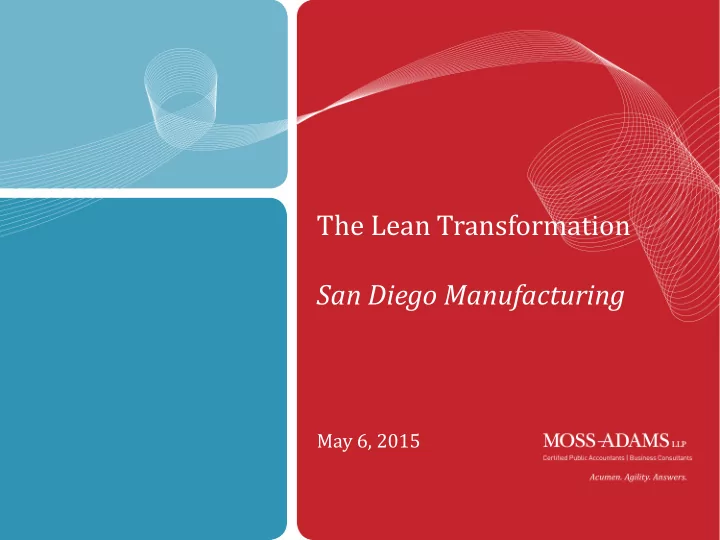

The Lean Transformation San Diego Manufacturing May 6, 2015 1
Presenter Rishi Malhotra Practice Leader, Operational Excellence Consulting Rishi is a Manager at Moss Adams. He has over 18 years of strategic and tactical Lean, Six Sigma, operations, consulting and manufacturing leadership experience. Rishi is passionate about working with clients to enhance top- line and bottom-line revenues, improve enterprise efficiency, implement market growth and cost reduction strategies, and inculcate a Lean and Six Sigma culture as part of long-term growth plans. Rishi Malhotra Practice Leader, Operational Excellence Consulting rishi.malhotra@mossadams.com (415) 848-0951 2
What is Lean? • A systematic approach to identifying and eliminating waste through continuous improvement by flowing the product at the pull of the customer in the pursuit of perfection. • The aim is to maximize customer value while minimizing waste. • The goal is to provide perfect value using a creation process that has zero waste. 3
Thinking – Lean Versus Traditional Traditional Thinking: Lean Thinking: • Best for the function • Best for the customer • Looks to the past to • Looks to the future to predict predict future performance performance • Single piece flow • Uses batch production • Closes performance gaps (sign all the approvals on Mondays, e.g.) • Encourages and supports • Ignores performance gaps change • Justifies and maintains the • Visual status quo • Encourages problem exposure • Hidden • Ignores problems 4
Value Added Versus Non-Value Added • Value Added is something the customer is willing to pay for. • Value Added is anything that changes: o Form. o Fit. o Function. • Non-Value Added is: o Everything else. WASTE 5
5S – Introduction The 5S methodology refers to workplace organization. It is the foundation and keystone of a Lean organization. It builds efficiency and effectiveness in an organization. The idea is to create and maintain an organized, clean, safe and a high-performance workplace. It is achieved through involvement of all employees. The five steps of this methodology are: Benefits include: • Improvement in morale and productivity metrics by 15 to 20 percent. • Improvement in quality metrics. • Lead time reduction by up to 25 percent. • Enhanced layout/flow. • Higher health and safety metrics. • A valuable sales tool during customer and potential customer visits. 6
Recommend
More recommend